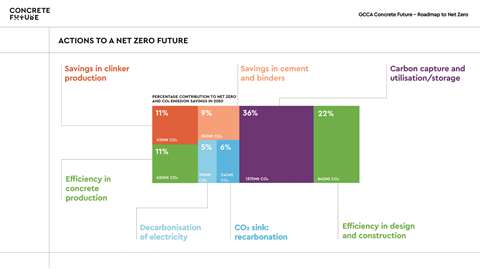GCCA: The path to net zero concrete
06 December 2021
Thomas Guillot, chief executive of the Global Cement and Concrete Association on the industry’s path to Net Zero Concrete and the sustainable world of tomorrow
The coming decades will be some of the most exciting and challenging in the history of the global construction industry. A surge in spending by governments around the world will be invested to improve old housing and infrastructure, and new buildings, roads, bridges and cities will be needed to accommodate the needs and quality of life of a changing global population – one that is expected to grow to 9.8 billion and be over two-thirds urbanised by 2050, according to the UN. That isn’t where the challenge ends.
Not only must this infrastructure be delivered, it must also be done in a sustainable way if we are to have any chance of limiting global warming to 1.5oC. As UN Secretary-General António Guterres recently told our members about the green infrastructure challenge, “Without credible action now, future generations will have no liveable planet to build upon.”

Much of this necessary development will be built with concrete. Concrete is the most used human-made material on the planet, with 14 billion cubic meters produced every year for use in every type of construction, ranging from bridges and tunnels to houses and hydropower installations to flood defences. However, the production of cement, which is the key ingredient in concrete, accounts for around 7% of global CO2 emissions.
Most of these emissions are released during the production phase, due to the chemical reaction that occurs in its making. With the growing demand on cement and concrete for infrastructure projects, it is imperative that we build the coming infrastructure on a foundation of more sustainable concrete.
The Global Cement and Concrete Association (GCCA) was created to represent the world’s leading cement and concrete manufacturers and ensure that concrete can continue to be the key material in sustainable construction.
 Thomas Guillot, chief executive of the Global Cement and Concrete Association.
Thomas Guillot, chief executive of the Global Cement and Concrete Association.
Our vision is to support economic, social and environmental development by supplying the world’s demand for a building material that is able to support modern, resilient and sustainable communities. We have 40 member companies from Europe, Africa, the Americas and Asia, representing 80% of total production outside China, as well as key Chinese manufacturers. Our membership includes global leaders like CEMEX, Holcim, HeidelbergCement, CRH and China National Building Materials (CNBM).
Climate action
GCCA was the first global ‘heavy’ industry to become an accelerator for the UN’s global Race to Zero, and, more recently, the first to release a detailed Roadmap to net zero for a whole global industry. Launched ahead of COP26, ‘Concrete Future – the GCCA 2050 Cement and Concrete Industry Roadmap for Net Zero Concrete’ outlines the key levers, actions and milestones that will be needed to fully decarbonise the industry by 2050, and cut emissions by a quarter by 2030 on the way to net zero.
 Cutting emissions from concrete is a key battle in construction’s race to net zero.
Cutting emissions from concrete is a key battle in construction’s race to net zero.
The Roadmap is built around a seven-point plan to achieve ambitious yet realistic actions. It includes boosting the offering of low carbon cement and concrete products, increasing circularity in our process and products – in particular reducing fossil fuel use in manufacturing – and accelerating innovation and breakthrough technologies such as carbon capture utilisation and storage, which already has several successful live projects underway around the world.
The cement and concrete industry will come together to lead the way on innovation, through the GCCA’s innovation arm, Innovandi. The Innovandi Global Cement and Concrete Research Network brings together academia and industry to collaborate on essential pre-competitive research in areas such as energy efficiency, more efficient clinker production and concrete recycling.
Meanwhile the Innovandi Open Challenge is a unique industry accelerator which is bringing together exciting start-ups from around the world with our member companies to develop new technologies to help us decarbonise.
GCCA climate partnerships
The cement and concrete industry can and is doing a lot, but we can’t do it all, and certainly not alone. We are asking for support from policymakers to create market demand for low carbon products in construction and public procurement. Here, policy reforms and the promotion of low carbon products can make a big difference as public infrastructure accounts for almost 60% of all global cement and concrete demand.
We also need policymakers to support carbon removal technologies, such as carbon capture utilisation and storage (CCUS) innovations. This technology, which has already been shown to work in the many projects that exist around the world, now needs to mature by the end of the decade. The industry itself is committed to ten industrial scale carbon capture plants by 2030.
 Concrete is the most used man made material on the planet.
Concrete is the most used man made material on the planet.
While the technology is advancing, the economies remain challenging. It is critical that the industry has government support to expand the successful pilots across the world towards commercial scale deployment.
We also need the wider construction industry to work with us toward the ambition of net zero concrete. Construction professionals, working with us and policymakers, will be key to developing the design and regulatory framework that will drive efficient use of resources and products, use of reprocessed and recycled material and the re-use of elements, as well as other technology to reduce materials and extend the lifetime of whole projects.
We are striving to create a sustainable partnership with all kinds of stakeholders across the world to deliver green concrete for future generations. I am proud of the commitment made by our members and look forward to working with the wider construction industry to conquer the global zero carbon challenge together.






